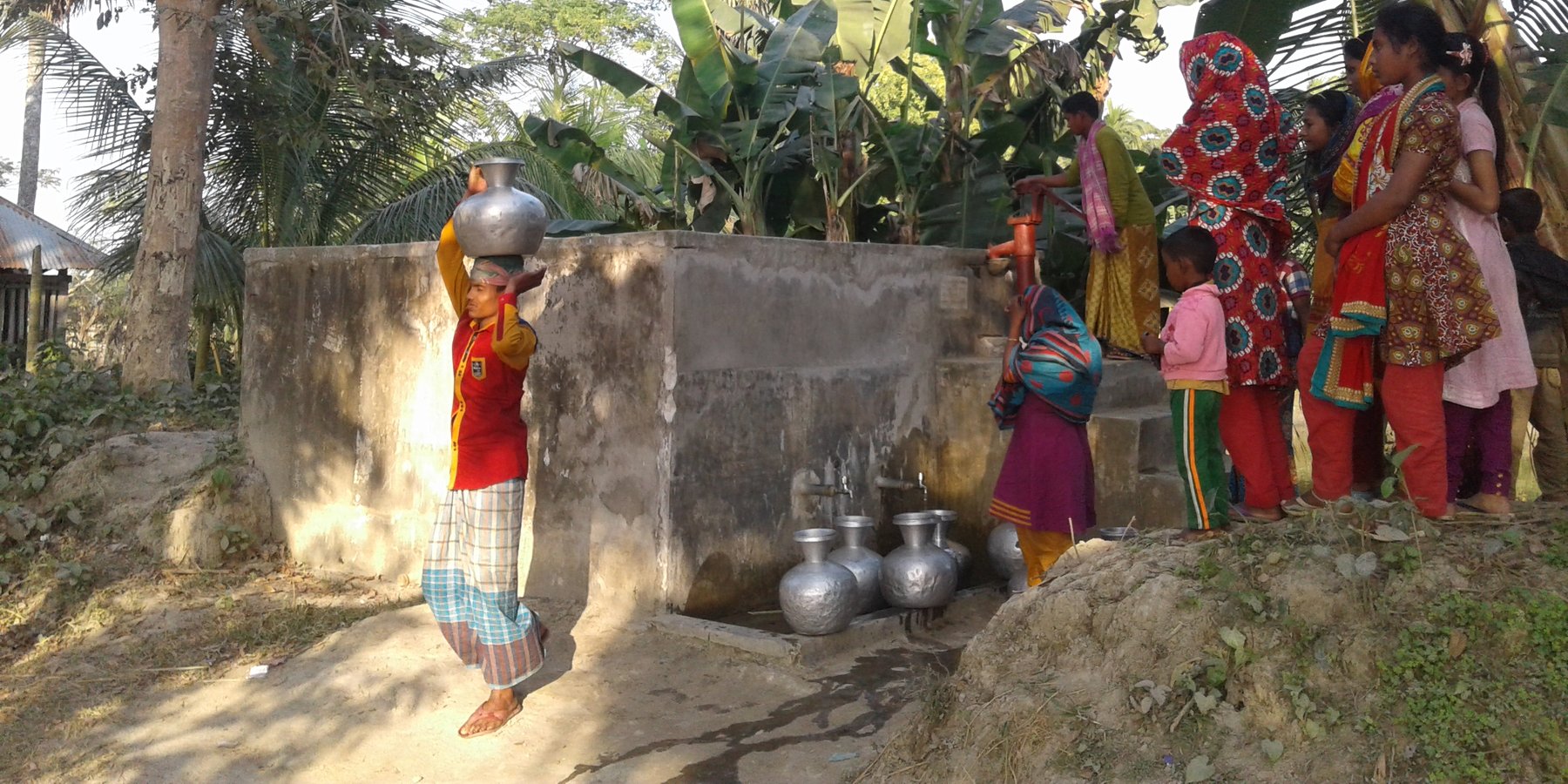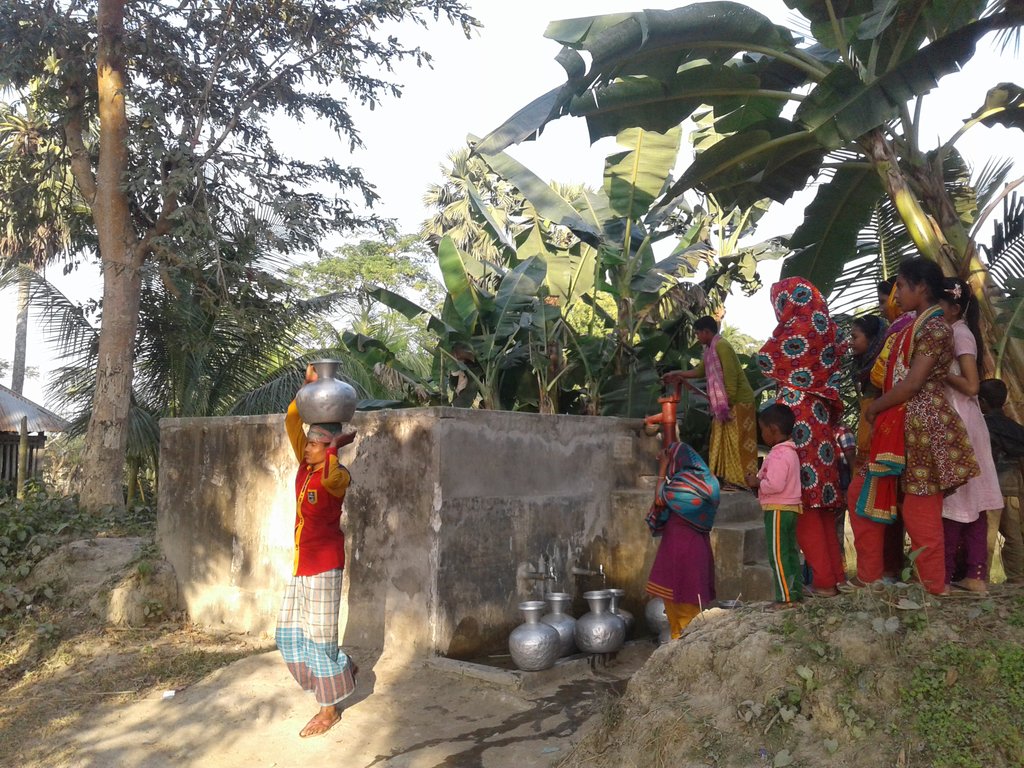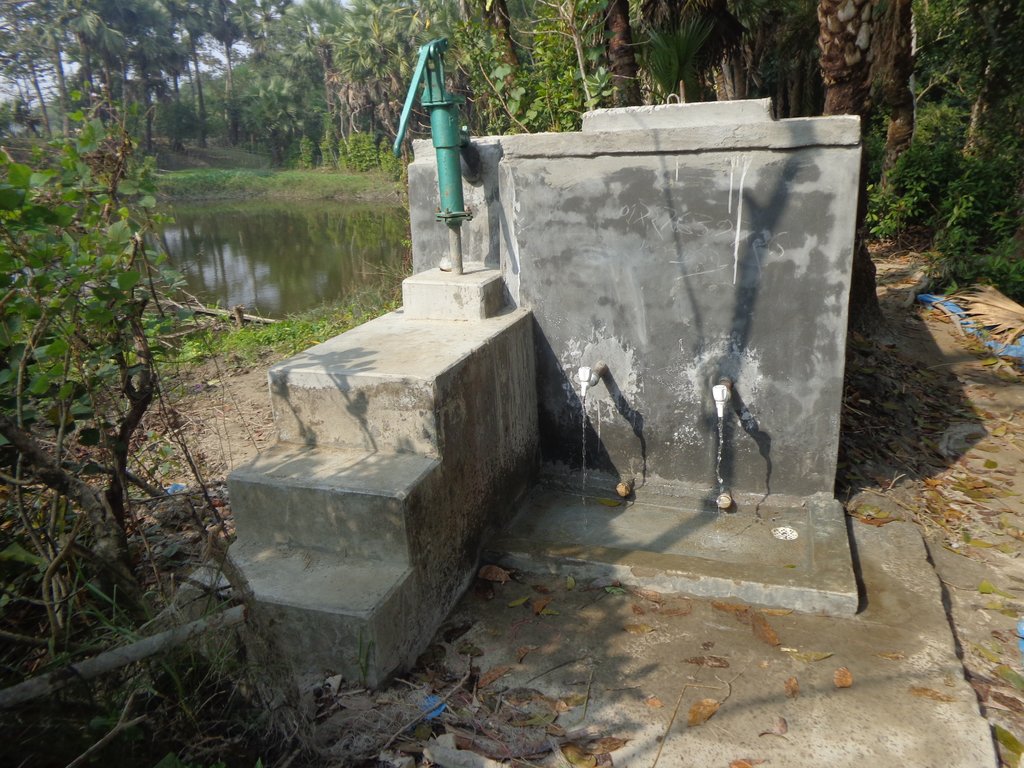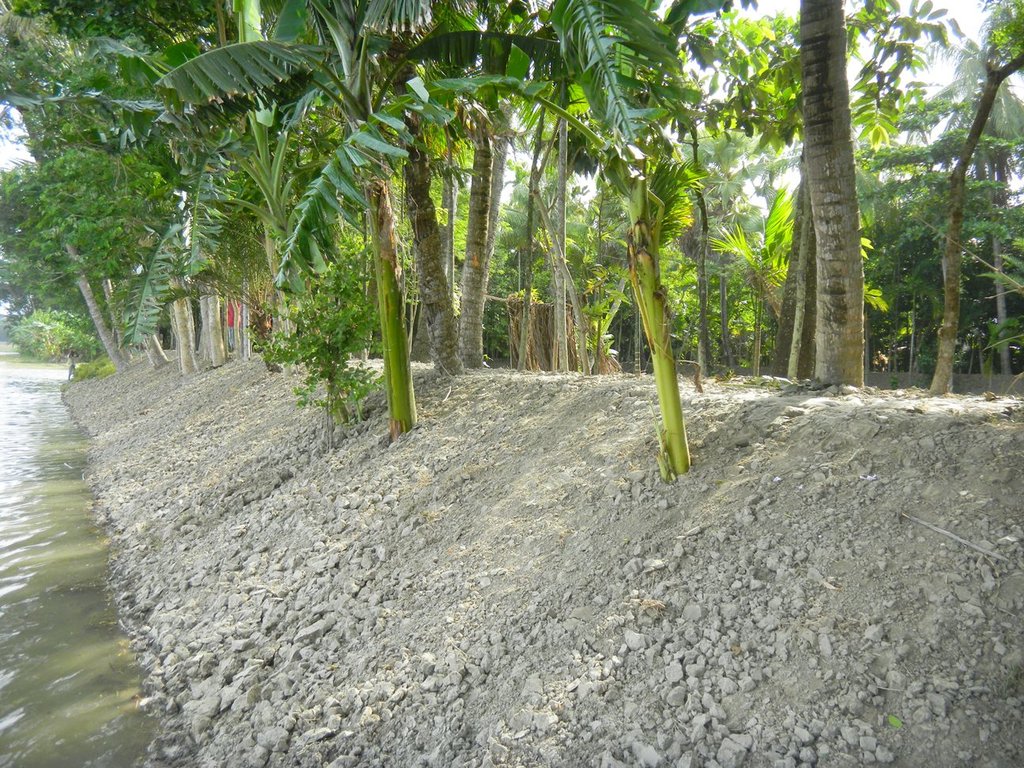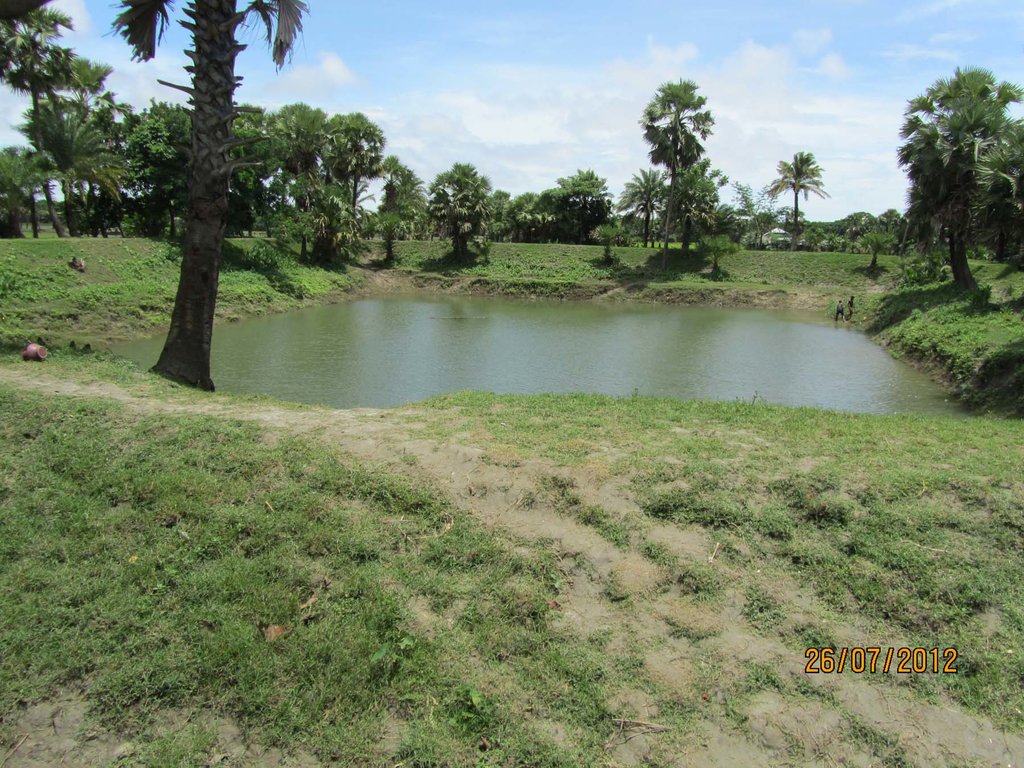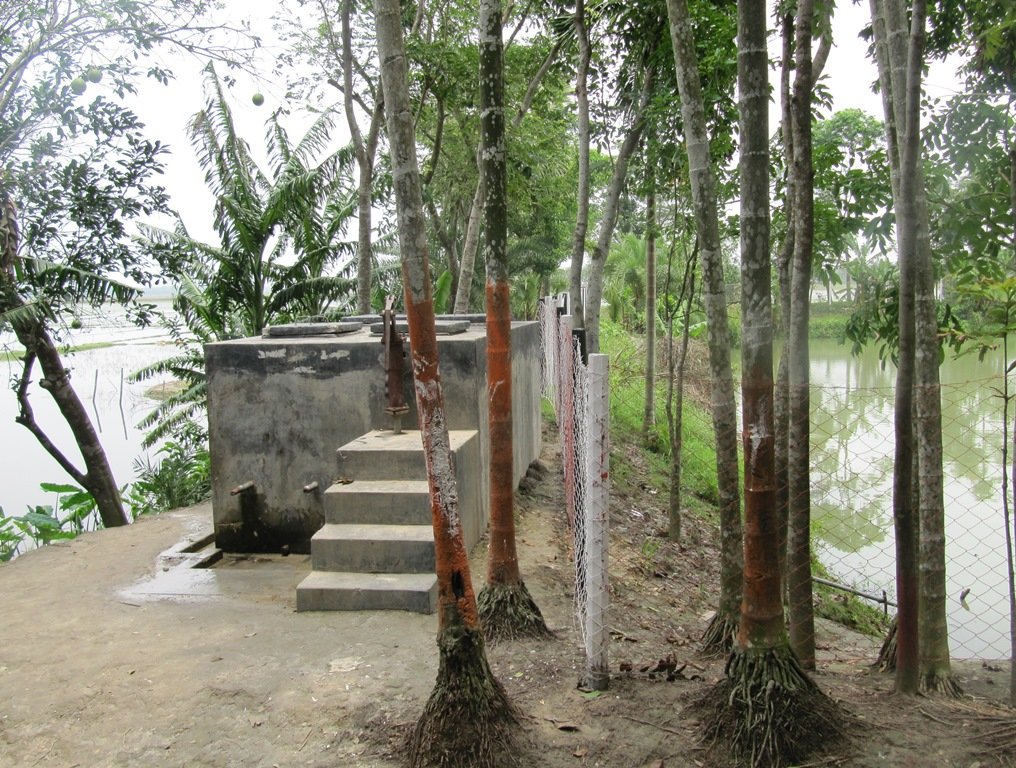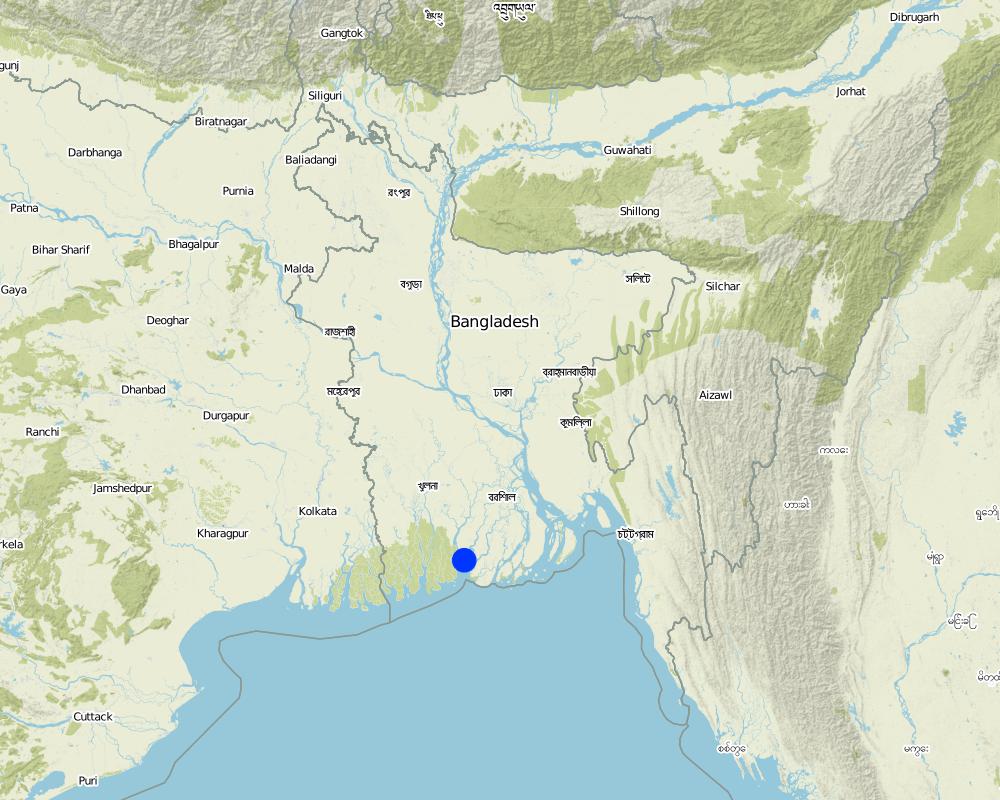Pond Sand Filter (PSF) with Raised Embankment [Bangladesh]
- Creación:
- Actualización:
- Compilador: John Brogan
- Editores: Shahid Kamal, Md. Rahmatullah Faruque
- Revisores: Alexandra Gavilano, Hanspeter Liniger, Nicole Harari, Deborah Niggli
FILTER
technologies_550 - Bangladesh
Visualizar secciones
Expandir todo Colapsar todos1. Información general
1.2 Detalles de contacto de las personas de referencia e instituciones involucradas en la evaluación y la documentación de la Tecnología
Nombre del proyecto que financió la documentación/ evaluación de la Tecnología (si fuera relevante)
Book project: where people and their land are safer - A Compendium of Good Practices in Disaster Risk Reduction (DRR) (where people and their land are safer)Nombre de la(s) institución(es) que facilitaron la documentación/ evaluación de la Tecnología (si fuera relevante)
Terre des Hommes (Terre des Hommes) - Suiza1.3 Condiciones referidas al uso de datos documentados mediante WOCAT
El compilador y la/s persona(s) de referencia claves aceptan las condiciones acerca del uso de los datos documentados mediante WOCAT:
Sí
1.4 Declaración de la sostenibilidad de la Tecnología descrita
¿La Tecnología aquí descrita resulta problemática en relación a la degradación de la tierra, de tal forma que no puede considerársela una tecnología sostenible para el manejo de la tierra?
No
2. Descripción de la Tecnología MST
2.1 Breve descripción de la Tecnología
Definición de la Tecnología:
The combination of pond sand filters (PSF) and raised pond embankments protect drinking water sources and increase the resilience to flood and tidal surge events in low-lying coastal areas.
2.2 Descripción detallada de la Tecnología
Descripción:
Coastal areas along the Bay of Bengal experience extreme seasonal variance in the presence of surface water including flooding, tidal surge, and drought. Many families living in these rural communities construct small ponds to ensure water availability for a variety of uses, such as washing, bathing, fish farming and animal watering as well as domestic use. Some families build larger ponds that are open to the use of all community members; whereby water is carried by women and children to households. Use of pond surface water may last up to several months during the year depending on the location, seasonal weather patterns, geologic conditions, capacity of the pond and user habits. Residents rely on ponds as a source of drinking water during the dry season when household rainwater harvesting techniques are no longer viable, making treatment essential.
Pond sand filters (PSF) is acentralised or semi-centralised water treatment technology often employed in many coastal areas where surface water is the only option due to saline aquifers and lack of resources for more robust, safely managed community water supply systems. The technology uses slow-sand filtration to remove turbidity (sediments) and pathogenic organisms whereby freshwater flows through layers of sand and gravel populated by a thin layer of microorganisms and treatment happens through physical and biological processes. Due to resource constraints, the number of PSF serving as water sources is usually limited. The technology considerably reduces the risk of infection with enteric pathogens. In conjunction with PSF, safe water transport (covered and cleaned containers) and household water treatment systems (chemical or additional filtration devices) are essential.
As stated in the Sustainable Sanitation and Water Management Toolbox (SSWM) slow sand filtration systems are characterised by a high reliability and rather low lifecycle costs. Moreover, neither construction nor operation and maintenance require more than basic skills. Hence, slow sand filtration is a promising filtration method for small to medium-sized, rural communities with a fairly good quality of the initial surface water source. As stated by the the World Health Organisation, slow sand filtration provides a simple but highly effective and considerably cheap tool that can contribute to a sustainable water management system.
Once a SSF facility is built, only clean sand is required for occasional replacement. The sand layers are put in gradually according to their grain sizes: rather coarse grains at the bottom and fine grains at the top. The sand-bed is usually covered with one meter of supernatant water (LOGSDON 2003). As the process of biological filtration requires a fair amount of time in order to improve effectiveness of water treatment, SSFs usually operate at slow flow rates between 0.1 – 0.3 m3/h per square metre of surface (WHO n.y.). The water thus remains in the space above the medium for several hours and larger particles are allowed to separate and settle. It then passes through the sand-bed where it goes through a number of purification processes (HUISMAN 1974).
Due to the risk of inland flooding and (seawater) tidal surges from offshore storms, communities build earthen embankments around the ponds to prevent contamination. Local authorities and community members must be involved in the design height of the embankment—which should be equivalent to the highest pre-recorded flood level. In the geo-referenced area (Patharghata) this is equivalent to the tidal surge of Cyclone Sidr (2007). Constructed roadways are often a good reference point. In southern Bangladesh , rural roadways are built to at a ten-year flood return period, so exceeding this height according to the means of the community and/or project is recommended.
Pond embankments are best raised with soil preferably of a clayey nature. The final covering layer must be rich in clay. Embankments should be planted with native grasses and flora that have strong root systems to stabilize slopes and prevent erosion during the rainy season and in cases of tidal surge due to storms. In Bangladesh, the native kolmi (Ipomoea) has proven effective. Community members have also planted crops on the embankments, such as banana trees, medicinal plants and even small garden trenches in the middle of the slope. Beyond structural support, the horticulture helps diversify nutrition and can provide a source of income for maintaining the pond sand filter.
Fences should be installed to prevent animals from entering ponds reserved for drinking water. Community members must guarantee that the ponds selected for PSF construction shall not be used for purposes such as: washing, bathing, fish farming (natural fish however can be allowed), direct cattle access washing and watering. Furthermore:
•Fertilizers and other chemicals shall never be allowed to go into the pond.
•The flow of any polluting materials in the vicinity of the pond shall always be directed away from the pond.
•Latrines, cowsheds, garbage dumps, graveyards, fuel outlets and similar polluting structures shall not be constructed within a distance of 30 meters from the pond.
•Duck or poultry rearing hanging sheds shall never be constructed over the pond.
2.3 Fotografías de la Tecnología
2.5 País/ región/ lugares donde la Tecnología fue aplicada y que se hallan comprendidos por esta evaluación
País:
Bangladesh
Región/ Estado/ Provincia:
Patharghata, Barguna district in coastal region
Especifique más el lugar :
Baratangra, Ward:4, Union: Patharghata Union Parishad
Especifique la difusión de la Tecnología:
- aplicada en puntos específicos/ concentrada en un área pequeña
Comentarios:
This technology may be applied to selected ponds within a community.
Map
×2.6 Fecha de la implementación
Si no se conoce el año preciso, indique la fecha aproximada:
- hace menos de 10 años (recientemente)
2.7 Introducción de la Tecnología
Especifique cómo se introdujo la Tecnología:
- como parte de un sistema tradicional (> 50 años)
- mediante proyectos/ intervenciones externas
3. Clasificación de la Tecnología MST
3.1 Propósito(s) principal(es) de la Tecnología MST
- reducir el riesgo de desastres naturales
- adaptarse al cambio climático/ extremos climáticos y sus impactos
3.2 Tipo(s) actuales de uso de la tierra donde se aplica la Tecnología
Mezcla de tipos de uso de tierras dentro de la misma unidad de tierras: :
Sí
Especifique el uso combinado de tierras (cultivos/ pastoreo/ árboles):
- Agroforestería

Tierras cultivadas
- Cosecha anual
- Cultivos perennes (no leñosos)
- Cosecha de árboles y arbustos
Cosechas anuales - Especifique cultivos:
- plantas y hierbas medicinales/ aromáticas/ plaguicidas
Cultivos perennes (no maderables) - Especifique cultivos:
- banana/plátano/abacá
Número de temporadas de cultivo por año:
- 2

Bosques
3.3 ¿Cambió el uso de tierras debido a la implementación de la Tecnología?
¿Cambió el uso de tierras debido a la implementación de la Tecnología?
- No (Continúe con la pregunta 3.4)
3.4 Provisión de agua
Provisión de agua para la tierra donde se aplica la Tecnología:
- de secano
3.5 Grupo MST al que pertenece la Tecnología
- manejo de agua superficial (manantial, río, lagos, mar):
3.6 Medidas MST que componen la Tecnología

medidas estructurales
- S2: Taludes, bancos
- S5: Diques, hondonadas, estanques
- S7: Equipo para cosechar agua / provisión de agua/ irrigación
3.7 Principales tipos de degradación de la tierra encarados con la Tecnología

erosión de suelos por agua
- Wt: pérdida de capa arable/ erosión de la superficie

degradación del agua
- Hs: cambio en la cantidad de aguas superficiales
- Hq: reducción de la calidad de subterráneas
Comentarios:
Preventing salt water intrusion, the surface water quality and quantity is protected. Turfing and planting the embankment prevents erosion.
3.8 Prevención, reducción o restauración de la degradación de la tierra
Especifique la meta de la Tecnología con relación a la degradación de la tierra:
- no aplica
4. Especificaciones técnicas, actividades de implementación, insumos y costos
4.1 Dibujo técnico de la Tecnología
Especificaciones técnicas (relacionadas al dibujo técnico):
PSF is built on top of the raised embankment as a reinforced concretes structure consisting of a sand filter chamber, filtered water chamber and the sedimentation tank. The height is 4 feet 2 inches; Length-14 feet 5 inches; Width-7 feet. The capacity of PSF is 2500 liters. The construction materials used include include brick, sand, brick chips, cement, galvanized iron pipe, water tap and rebar.
The medium in the filter chamber shall comprise of three layers: 1) filter sand of 2 feet (60 cm) depth placed above 2) a 3” layer of fine gravel and 3) a 3" layer of coarse gravel.
1) The filter sand shall have the following size and grade: (a) Sand grains in the range 0.1 to 1 mm, with (b) effective size ( d10) in the range 0.15 to 0.20; and (c) Uniformity Coefficient ( d60/d10) in the range 1.5 to 2.5. Sieves are used to test sand size and grade.
The "under drainage" bottom gravel layers:
2) Fine gravel: 3” layer ¼” to 1 mm grains (gravel that passes through the ¼” sieve and are retained on 1 mm sieve)
3) Coarse gravel: 3" layer of ½” to ¼” grains (gravel that passes through ½” sieve and are retained on ¼” sieve)
Use different sized sieves made of wire mesh in wooden frame to prepare the media to prepare the two layers of gravel.
Every 5-6 weeks (or when flow rate is limited) cleaning the filter should be performed. Remove the filter aggregate layers, clean the PSF by removing any remaining objects in the three chambers (sand filter chamber, filtered water chamber and the sedimentation tank). Clean these chambers thoroughly using hard brush in necessary. Sequentially clean and replace t the coarse gravel media, then the fine gravel media, and finally the filter sand. For cleaning the gravel and sand place about 1/4th bucket of grave or the sand in plastic bucket (8, 10 or 12 liters, whichever may be convenient), pour about ½ bucket of water and then wash lifting the gravel or the sand from the bottom with hand several times, then decant the water by tilting the bucket. (Only fine particles less than 0.1 mm should be poured out while washing the sand.)
Raised Pond embankments are built with earthworks of clayey soils designed per the maximum flood height. The design depicted in this section is an indication, however the services of a qualified structural/civil engineer will be required. In general building the embankment is raised 0.6m above the maximum flood level is recommended, at a slope of 1:2. From the ground level, the average height of an embankment is two meters, and the average excavation depth is also two meters. All plans for both embankment works and PSF construction were reviewed and approved by the Bangladesh Government Department of Public Health and Engineering.
Autor:
Terre des hommes
Fecha:
30/06/2016
4.2 Información general sobre el cálculo de insumos y costos
Especifique cómo se calcularon los costos e insumos:
- por unidad de Tecnología
Especifique unidad:
Pond Sand Filter with raised earthen embankment
Especifique las dimensiones de la unidad (si fuera relevante):
2,500 Litres capacity of filter; embankment average of 100 meter perimeter.
Especifique la moneda usada para calcular costos:
- USD
Indique el costo promedio del salario de trabajo contratado por día:
5 $ per day for labor
4.3 Actividades de establecimiento
| Actividad | Momento (estación) | |
|---|---|---|
| 1. | Community consultation for Committee Formation | Before onset of rain |
| 2. | Create PSF Users' Committee, agre on user contributions | Before onset of rain |
| 3. | Committee / pond selection approved by local Government | Before onset of rain |
| 4. | Technical orientation to PSF Committee, input on designs | Before onset of rain |
| 5. | Excavation of Pond | Before onset of rain |
| 6. | Embankment Construction | Before onset of rain |
| 7. | PSF Construction | |
| 8. | Fencing | |
| 9. | Turfing and hortiuclutre on the embankment | Before onset of rain |
| 10. | PSF Training on Media Selection and maintenance | Regular intervals throughout the year (every 1-2 months) |
| 11. | Pond embankment maintenance | Before onset of rain |
Comentarios:
In general, the community approach begins with several consultation meetings in the community (inclusive: gender balanced and representative of the diversity makeup of the community) and with municipal authorities. An Outcome Mapping process is initiated to observe signs that a village is prepared and mobilized to receive support for PSF and pond embankment construction. Families must be willing to participate and contribute in the construction and take complete responsibility for operation and routine maintenance.
During the initial phase, a PSF Users’ Committee is formed and approved by the municipal government. Its members make time to participate in trainings on the design, use, maintenance and community organization for managing a PSF. Importantly, the PSF User’s committee must seek public commitments toward the construction costs in cash and/or in kind (labor, construction materials, embankments plants, etc). In Bangladesh this was 10% and usually in kind. Roles and responsibilities of the PSF Users’ Committee:
1)Be responsible for regular operation, maintenance and cleanliness of the pond sand filter;
2)Ensure that the maintenance points for pond water quality is respected per the manual;
3)Advocate for local authorities to conduct regular water quality testing; and to promote household water treatment systems
4)Establish a system of collecting money from users for the regular maintenance;
5)Organize Committee meetings before the start of each season and whenever needed. Similarly if required organize a wider meeting with users in connection with resolving any O&M issues.
6)Care for the tools and other materials that may be purchased for the pond sand filter.
Selection of ponds for PSF construction should be participative with criteria agreed and communicated with the community members and local authorities. The following criteria are suggested based on Terre des hommes’ experience in Bangladesh:
•Ponds that are large enough to retain water throughout the dry season.
•The salinity of the pond water must not exceed 600 ppm at any time of the year.
•While the location of the PSF should be close to a family to ensure its security, it must be as centrally located as possible for ease of access
•Freely accessible to the public; ideally donated for public use.
•Ponds located on higher ground and thus more resistant to flooding / sea water intrusion.
•Space available for raising the embankments around the ponds
•Ponds most accessible to a largest segment of the population during disaster.
•Each PSF should have an effective drainage space and system.
4.4 Costos e insumos necesarios para el establecimiento
| Especifique insumo | Unidad | Cantidad | Costos por unidad | Costos totales por insumo | % de los costos cubiertos por los usuarios de las tierras | |
|---|---|---|---|---|---|---|
| Mano de obra | Pond Excavation and Embankment Raising | Person-days | 180,0 | 5,0 | 900,0 | 10,0 |
| Mano de obra | Pond Fencing Works | Person-days | 20,0 | 5,0 | 100,0 | |
| Mano de obra | Masonry | Person-days | 36,0 | 6,25 | 225,0 | |
| Equipo | Repairing tools | Set | 1,0 | 15,0 | 15,0 | |
| Equipo | Tubewell/handpump | Pieces | 1,0 | 35,0 | 35,0 | 10,0 |
| Equipo | Sanitary Fittings | Set | 1,0 | 100,0 | 100,0 | |
| Fertilizantes y biocidas | Bleaching powder for disinfection | kg | 2,0 | 1,0 | 2,0 | 10,0 |
| Fertilizantes y biocidas | Lime for cleaning | kg | 50,0 | 0,5 | 25,0 | |
| Material de construcción | bricks | pieces | 6000,0 | 0,075 | 450,0 | 10,0 |
| Material de construcción | cement | 50 Kilo Bags | 50,0 | 5,75 | 287,5 | 10,0 |
| Material de construcción | sand | cubic feet | 52,0 | 0,375 | 19,5 | |
| Material de construcción | mild steel round bar | kg | 210,0 | 0,75 | 157,5 | |
| Otros | Materials Transport Cost | Lump Sum | 1,0 | 185,0 | 185,0 | 10,0 |
| Costos totales para establecer la Tecnología | 2501,5 | |||||
| Costos totales para establecer la Tecnología en USD | 2501,5 | |||||
Si el usuario de la tierra no cubrió el 100% de los costos, indique quién financió el resto del costo:
The project requested 10% contribution in kind (materials, transport, labor) from each community. The remaining costs were covered by the project.
Comentarios:
The budget is for raising a 100m perimeter length of embankment.
4.5 Actividades de establecimiento/ recurrentes
| Actividad | Momento/ frequencia | |
|---|---|---|
| 1. | Repairing | Before onset of rains |
| 2. | Cleaning | Before onset of rains |
4.6 Costos e insumos necesarios para actividades de mantenimiento/ recurrentes (por año)
| Especifique insumo | Unidad | Cantidad | Costos por unidad | Costos totales por insumo | % de los costos cubiertos por los usuarios de las tierras | |
|---|---|---|---|---|---|---|
| Mano de obra | two-monthly cleaning of filter materials | Person days | 12,0 | 5,0 | 60,0 | 100,0 |
| Mano de obra | Seasonal erosion control | Person days | 12,0 | 5,0 | 60,0 | 100,0 |
| Fertilizantes y biocidas | bleeching powder | bag | 5,0 | 2,0 | 10,0 | 100,0 |
| Indique los costos totales para mantenecer la Tecnología | 130,0 | |||||
| Costos totales para mantener la Tecnología en USD | 130,0 | |||||
4.7 Factores más determinantes que afectan los costos:
Describa los factores más determinantes que afectan los costos:
Comparatively, construction materials costs was reflected as the most expensive consideration.
5. Entorno natural y humano
5.1 Clima
Lluvia anual
- < 250 mm
- 251-500 mm
- 501-750 mm
- 751-1,000 mm
- 1,001-1,500 mm
- 1,501-2,000 mm
- 2,001-3,000 mm
- 3,001-4,000 mm
- > 4,000 mm
Indique el nombre de la estación metereológica de referencia considerada:
www.discoverybangladesh.com
Zona agroclimática
- semi-árida
5.2 Topografía
Pendientes en promedio:
- plana (0-2 %)
- ligera (3-5%)
- moderada (6-10%)
- ondulada (11-15%)
- accidentada (16-30%)
- empinada (31-60%)
- muy empinada (>60%)
Formaciones telúricas:
- meseta/ planicies
- cordilleras
- laderas montañosas
- laderas de cerro
- pies de monte
- fondo del valle
Zona altitudinal:
- 0-100 m s.n.m.
- 101-500 m s.n.m.
- 501-1,000 m s.n.m
- 1,001-1,500 m s.n.m
- 1,501-2,000 m s.n.m
- 2,001-2,500 m s.n.m
- 2,501-3,000 m s.n.m
- 3,001-4,000 m s.n.m
- > 4,000 m s.n.m
Indique si la Tecnología se aplica específicamente en:
- no relevante
5.3 Suelos
Profundidad promedio del suelo:
- muy superficial (0-20 cm)
- superficial (21-50 cm)
- moderadamente profunda (51-80 cm)
- profunda (81-120 cm)
- muy profunda (>120 cm)
Textura del suelo (capa arable):
- fina/ pesada (arcilla)
Textura del suelo (> 20 cm debajo de la superficie):
- fina/ pesada (arcilla)
Materia orgánica de capa arable:
- media (1-3%)
5.4 Disponibilidad y calidad de agua
Agua subterránea:
5-50 m
Disponibilidad de aguas superficiales:
pobre/ ninguna
Calidad de agua (sin tratar):
agua potable de mala calidad (requiere tratamiento)
¿La salinidad del agua es un problema?
Sí
Especifique:
groundwater table is salty along the Bay of Bengal, salt water intrusion. Tidal surge following cyclones also creates soil salinity.
¿Se está llevando a cabo la inundación del área? :
Sí
Frecuencia:
frecuentemente
5.5 Biodiversidad
Diversidad de especies:
- mediana
Diversidad de hábitats:
- mediana
5.6 Las características de los usuarios de la tierra que aplican la Tecnología
Sedentario o nómada:
- Sedentario
Orientación del mercado del sistema de producción:
- mixta (subsistencia/ comercial)
Ingresos no agrarios:
- 10-50% de todo el ingreso
Nivel relativo de riqueza:
- pobre
Individuos o grupos:
- individual/ doméstico
- grupos/ comunal
Nivel de mecanización:
- trabajo manual
- tracción animal
Género:
- mujeres
- hombres
Edad de los usuarios de la tierra:
- jóvenes
- personas de mediana edad
5.7 Área promedio de la tierra usada por usuarios de tierra que aplican la Tecnología
- < 0.5 ha
- 0.5-1 ha
- 1-2 ha
- 2-5 ha
- 5-15 ha
- 15-50 ha
- 50-100 ha
- 100-500 ha
- 500-1,000 ha
- 1,000-10,000 ha
- > 10,000 ha
¿Esto se considera de pequeña, mediana o gran escala (refiriéndose al contexto local)?
- pequeña escala
5.8 Tenencia de tierra, uso de tierra y derechos de uso de agua
Tenencia de tierra:
- individual, sin título
- individual, con título
Derechos de uso de tierra:
- individual
Derechos de uso de agua:
- acceso abierto (no organizado)
5.9 Acceso a servicios e infraestructura
salud:
- pobre
- moderado
- bueno
educación:
- pobre
- moderado
- bueno
asistencia técnica:
- pobre
- moderado
- bueno
empleo (ej. fuera de la granja):
- pobre
- moderado
- bueno
mercados:
- pobre
- moderado
- bueno
energía:
- pobre
- moderado
- bueno
caminos y transporte:
- pobre
- moderado
- bueno
agua potable y saneamiento:
- pobre
- moderado
- bueno
servicios financieros:
- pobre
- moderado
- bueno
6. Impactos y comentarios para concluir
6.1 Impactos in situ demostrados por la Tecnología
Impactos socioeconómicos
Producción
producción de cultivo
Comentarios/ especifique:
Embankments provide a modest space for small scale gardening and fruit/medicinal tree cultivation. Such agriculture activities would be protected from tidal surge waters that destroy agriculture in low-lying areas.
Disponibilidad y calidad de agua
disponibilidad de agua potable
Comentarios/ especifique:
Terre des hommes had raised embankments on ten community ponds prior to cyclone Mahasen (2013). Nine of the ten ponds embankments remained intact, preserving valuable fresh water from sea water contamination for drinking after treatment with PSF.
calidad de agua potable
Cantidad antes de MST:
>1000 fecal coliform units
Cantidad luego de MST:
<10 fecal coliform units
Comentarios/ especifique:
The PSF water source considerably reduces the risk of infection with enteric pathogens from the pond water. In Terre des hommes’ field experience, although a reduction in presence of fecal coliform (FC) by over 99% is possible, the PSF technology rarely eliminates all FC. A level of 1-10 fecal coliform units (FCU: colonies of E. coli per 100 mL of water) has been achieved, which is equivalent to an intermediate risk, or “probably safe” as defined by WHO. In conjunction with PSF, safe water transport (covered and cleaned containers) and household water treatment systems (chemical or additional filtration devices) are essential.
Ingreso y costos
disparidades económicas
Impactos socioculturales
situación de salud
Comentarios/ especifique:
Users reported a decrease in water borne diseases through use of PSF water compared to surface water.
6.2 Impactos fuera del sitio demostrados por la Tecnología
disponibilidad de agua
Comentarios/ especifique:
During disaster, the use of the PSF increased, with people walking from further distances to take water from the PSF to their homes.
6.3 Exposición y sensibilidad de la Tecnología al cambio climático gradual y a extremos relacionados al clima/ desastres (desde la percepción de los usuarios de tierras)
Extremos (desastres) relacionados al clima
Desastres climatológicos
| ¿Cómo es que la tecnología soporta esto? | |
|---|---|
| sequía | bien |
Desastres hidrológicos
| ¿Cómo es que la tecnología soporta esto? | |
|---|---|
| marea tormentosa/ inundación costera | muy bien |
Comentarios:
PSF serves as disaster resilient Technology that helps residents in coastal villages along the Bay of Bengal to cope with the effects of climate change; such as increased incidence and intensity of storms and salt water intrusion.
6.4 Análisis costo-beneficio
¿Cómo se comparan los beneficios con los costos de establecimiento (desde la perspectiva de los usuarios de tierra)?
Ingresos a corto plazo:
ligeramente positivo
Ingresos a largo plazo:
positivo
¿Cómo se comparan los beneficios con los costos de mantenimiento/ recurrentes (desde la perspectiva de los usuarios de tierra)?
Ingresos a corto plazo:
neutral/ balanceado
Ingresos a largo plazo:
positivo
6.5 Adopción de la Tecnología
- > 50%
De todos quienes adoptaron la Tecnología, ¿cuántos lo hicieron espontáneamente, por ej. sin recibir nada de incentivos/ materiales:
- 0-10%
6.6 Adaptación
¿La tecnología fue modificada recientemente para adaptarse a las condiciones cambiantes?
No
6.7 Fuerzas/ ventajas/ oportunidades de la Tecnología
| Fuerzas/ ventajas/ oportunidades desde la perspectiva del usuario de la tierra |
|---|
| The Technology is useful for supplying drinking water at household level and supports cultivation of fruit trees, medicinal plants and vegetables at the pond embankment, above the flood line. |
| Fuerzas/ ventajas/ oportunidades desde la perspectiva del compilador o de otra persona de referencia clave |
|---|
| The Technology is conducive for ensuring supply of water for drinking, cooking and irrigation purposes if the community is motivated and understands the impact of PSF when faced with water shortage during dry season and other disaster events. |
6.8 Debilidades/ desventajas/ riesgos de la Tecnología y formas de sobreponerse a ellos
| Debilidades/ desventajas/ riesgos desde la perspectiva del compilador o de otra persona de referencia clave | ¿Cómo sobreponerse a ellas? |
|---|---|
| Every five to six weaks, the PSF filter media needs to be maintained, requiring some training, as well organising labor and collecting petty funds for bleaching powder. | The PSF User's Manual has been translated into local language with images and tips for maintenance. This is distributed following the training. The PSF User's Committee must regularly collect user fees for smooth operations. A bank account promotes transparency. Sale of crops harvested on the embankments can help defray costs of maintenance. |
| Although not laborious, the hand pump requires some degree of force, and the taps are often a target of children's play. | Children should be supervised and small children must not be allowed to operate or play near the pump. Investing in sturdy tap systems is essential. |
| The bio-film will form after seven days of operating the pump. | Users must boil or treat water very carefully in this period. |
| Private owners could lose interest availing their asset for the communty. For example, they may start using the pond for fish farming in order to sustain their livelihoods. | Formal agreements with the municipality about the usage rules for the pond, and public commitments taken by the pond owners are important. Posting signboards that identify the pond as "Drinking Water Only" and specify forbidden activities is also helpful. Owners can take a higher share of crops cultivated on the embankment. |
7. Referencias y vínculos
7.1 Métodos/ fuentes de información
- visitas de campo, encuestas de campo
Interviews with six informants
- compilación de informes y otra documentación existente
Compilation from five documents from past projects.
¿Cuándo se compilaron los datos (en el campo)?
16/08/2016
7.2 Vínculos a las publicaciones disponibles
Título, autor, año, ISBN:
SSWM University Course Module 6: Disaster Situations: Planning and Preparedness Further Resources: Water Purification Slow Sand Filtration, Marco A. Bruni, Dorothee Spuhler (seecon international gmbh), 2012.
¿Dónde se halla disponible? ¿Costo?
https://www.sswm.info/sswm-university-course/module-6-disaster-situations-planning-and-preparedness/further-resources-0/slow-sand-filtration
Título, autor, año, ISBN:
Pond Sand Filter (PSF) Manual – community operation and maintenance, Laxman Kharal (Terre des hommes), 2012
¿Dónde se halla disponible? ¿Costo?
Contact: info@tdh.ch
Título, autor, año, ISBN:
Guidelines for Drinking Water Quality, 4th Edition, WHO, 2011
¿Dónde se halla disponible? ¿Costo?
http://www.who.int/water_sanitation_health/publications/2011/dwq_guidelines/en/
Vínculos y módulos
Expandir todo Colapsar todosVínculos
No hay vínculos
Módulos
No se hallaron módulos


